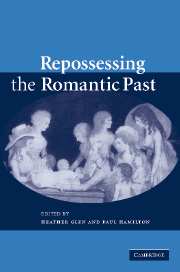Book contents
- Frontmatter
- Contents
- Notes on contributors
- Introduction
- PART I DISSENT AND OPPOSITION
- 1 ‘Severe contentions of friendship’: Barbauld, conversation, and dispute
- 2 Hazlitt's visionary London
- 3 Shelley's republics
- 4 Memoirs of a dutiful niece: Lucy Aikin and literary reputation
- 5 Holding Proteus: William Godwin in his letters
- PART II REOPENING THE CASE OF EDGEWORTH
- PART III DIFFERENT DIRECTIONS
- Marilyn Butler: a bibliography
- Index
2 - Hazlitt's visionary London
Published online by Cambridge University Press: 15 December 2009
- Frontmatter
- Contents
- Notes on contributors
- Introduction
- PART I DISSENT AND OPPOSITION
- 1 ‘Severe contentions of friendship’: Barbauld, conversation, and dispute
- 2 Hazlitt's visionary London
- 3 Shelley's republics
- 4 Memoirs of a dutiful niece: Lucy Aikin and literary reputation
- 5 Holding Proteus: William Godwin in his letters
- PART II REOPENING THE CASE OF EDGEWORTH
- PART III DIFFERENT DIRECTIONS
- Marilyn Butler: a bibliography
- Index
Summary
Although an aggrieved sense of neglect persists among some of his admirers, William Hazlitt has in fact enjoyed a striking critical revival, to the point where one London reviewer's estimate of his ‘soaring’ reputation ‘as one of the great figures in our literature’ seems no more than an enthusiastic overstatement of his emergence from literary minority. In particular, the treatment of Hazlitt as a committed radical essayist has come a long way since Herschel Baker's 1962 critical biography, with its invidious comparison between the ‘angry and uneven’ volume of Political Essays and the subsequent lectures and essays on English literature that are said to secure his reputation. And this was the view of a sympathetic biographer. Other responses in the same period, often guided by an understanding of the English Romantic imagination as a redemptive transcendence of betrayed revolutionary expectation, found little use for a body of political writing that developed under immediate journalistic pressures, and kept an abiding and prosaic faith with the French Revolution – to say nothing of Hazlitt's perverse insistence on associating the Lake school with pensioned apostasy rather than apocalypse by imagination. As in so many other areas of Romantic studies, Marilyn Butler set the terms for Hazlitt's resurgent reputation by decisively recontextualizing the politics of revolution and counterrevolution alike in her 1981 study Romantics, Rebels, and Reactionaries, in which Hazlitt figures as engaged radical journalist, persistent sectarian, and keeper of revolutionary faith, and as an emerging ‘new professional type, the star journalist’.
- Type
- Chapter
- Information
- Repossessing the Romantic Past , pp. 40 - 62Publisher: Cambridge University PressPrint publication year: 2006
- 3
- Cited by

